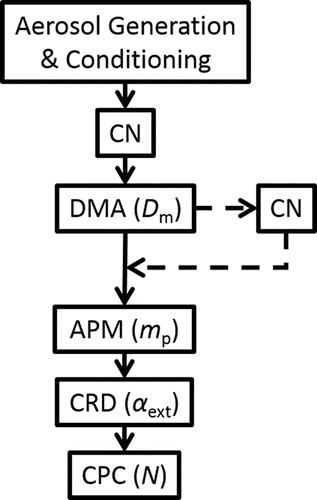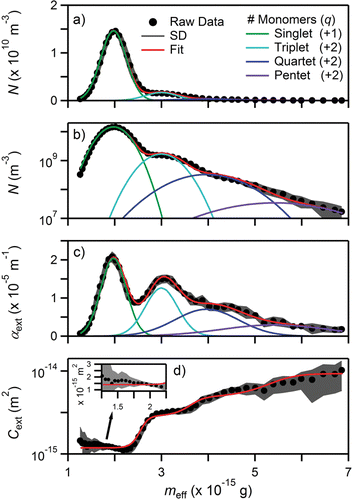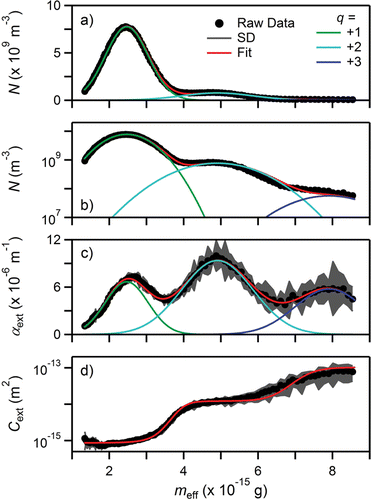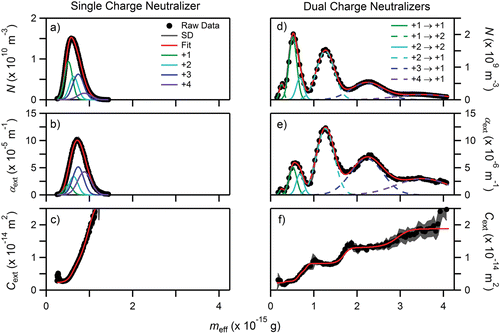Figures & data
Figure 1. Schematic of the theoretical transfer functions and separation of aerosol particles at an electrical mobility (Zp) and mass (mp) combination using a tandem DMA and APM. Panels (a), (b), (c), and (d) represent the transfer function of the DMA (ΩDMA), the transfer function of the APM (ΩAPM), the convolution of DMA and APM transfer functions (ΩDMA ΩAPM), and the convoluted transfer function after being weighted to the appropriate Boltzmann charge distribution (Pq) from the charge neutralizer, respectively, when only particles bearing a single charge are considered. Panels (e)–(h) follow the same progression as (a)–(d) except that the contributions of multiply charged particles have been included. There are three traces with different charges overlapped in (e) because they possess identical electrical mobility values, see Equation (Equation5[5] ). In (b)–(d), distributions are plotted against mp since q = +1 while in (f)–(h) distributions are plotted against meff as q > +1 are present. For more detail, see discussion in text.
![Figure 1. Schematic of the theoretical transfer functions and separation of aerosol particles at an electrical mobility (Zp) and mass (mp) combination using a tandem DMA and APM. Panels (a), (b), (c), and (d) represent the transfer function of the DMA (ΩDMA), the transfer function of the APM (ΩAPM), the convolution of DMA and APM transfer functions (ΩDMA ΩAPM), and the convoluted transfer function after being weighted to the appropriate Boltzmann charge distribution (Pq) from the charge neutralizer, respectively, when only particles bearing a single charge are considered. Panels (e)–(h) follow the same progression as (a)–(d) except that the contributions of multiply charged particles have been included. There are three traces with different charges overlapped in (e) because they possess identical electrical mobility values, see Equation (Equation5[5] ). In (b)–(d), distributions are plotted against mp since q = +1 while in (f)–(h) distributions are plotted against meff as q > +1 are present. For more detail, see discussion in text.](/cms/asset/3e1b6161-e695-4f11-90c7-d4688ad7ec34/uast_a_1136733_f0001_oc.gif)
Figure 2. Schematic of the experimental setup used in this study. Solid lines indicate primary flows and dashed lines indicate optional flows. Measured quantities are shown in parenthesis. Abbreviations: CN, charge neutralizer; DMA, differential mobility analyzer; APM, aerosol particle mass analyzer; CRD, cavity ring-down spectrometer; CPC, condensation particle counter (CPC).

Figure 3. (a) Number concentration (N) on linear axis, (b) number concentration (N) on logarithmic axis, (c) extinction (αext), and (d) extinction cross section (Cext) as a function of particle mass (mp) for polystyrene latex spheres with a nominal diameter of 147 ± 3 nm. Inset: Cext on a linear axis over the range 1.25 × 10−15 g to 2.25 × 10−15 g. DMA was set to Dm = 147 nm. Number concentration plotted on linear and logarithmic axes to highlight peak separation and contribution of q > +1, respectively. Measurement uncertainties are 2σ (SD).

Table 1. Fit coefficients for peaks observed in the mass distribution of PSL nanospheres of three nominal diameters.
Table 2. Calculated values for q = +1 PSL from fit coefficients in .
Table 3. Fit coefficients for peaks observed in the mass distribution of Dm = 150 nm AS.
Figure 4. (a) Number concentration (N) on linear axis, (b) number concentration (N) on logarithmic axis, (c) extinction (αext), and (d) extinction cross section (Cext) as a function of particle mass (mp) for ammonium sulfate with Dm = 150 nm. Number concentration plotted on linear and logarithmic axes to highlight peak separation and contribution on q > +1 particles, respectively. Measurement uncertainties are 2σ (SD); uncertainties in (a) and (b) were smaller than data points in the plot and have thus been omitted.

Table 4. Calculated values for Dm D 150 nm AS from the fit coefficients.
Figure 5. Left column: (a) size distribution (dN/dlog(Dm)), (b) number concentration, (c) extinction (αext), and (d) extinction cross section (Cext) as a function of mass for soot particles with a Zp = 1.3661 × 10−8 m2 V−1 s−1 corresponding to a q = +1 Dm of 150 nm using a single charge neutralizer (CN) with a differential mobility analyzer (DMA) and aerosol particle mass analyzer (APM). Right column: same order as the left column except that the particles have been passed through a second charge neutralizer prior to entering the APM causing a redistribution of particle charge. Error bars are 2σ. See discussion in text for additional details.

Table 5. Soot mass distribution fits from .
